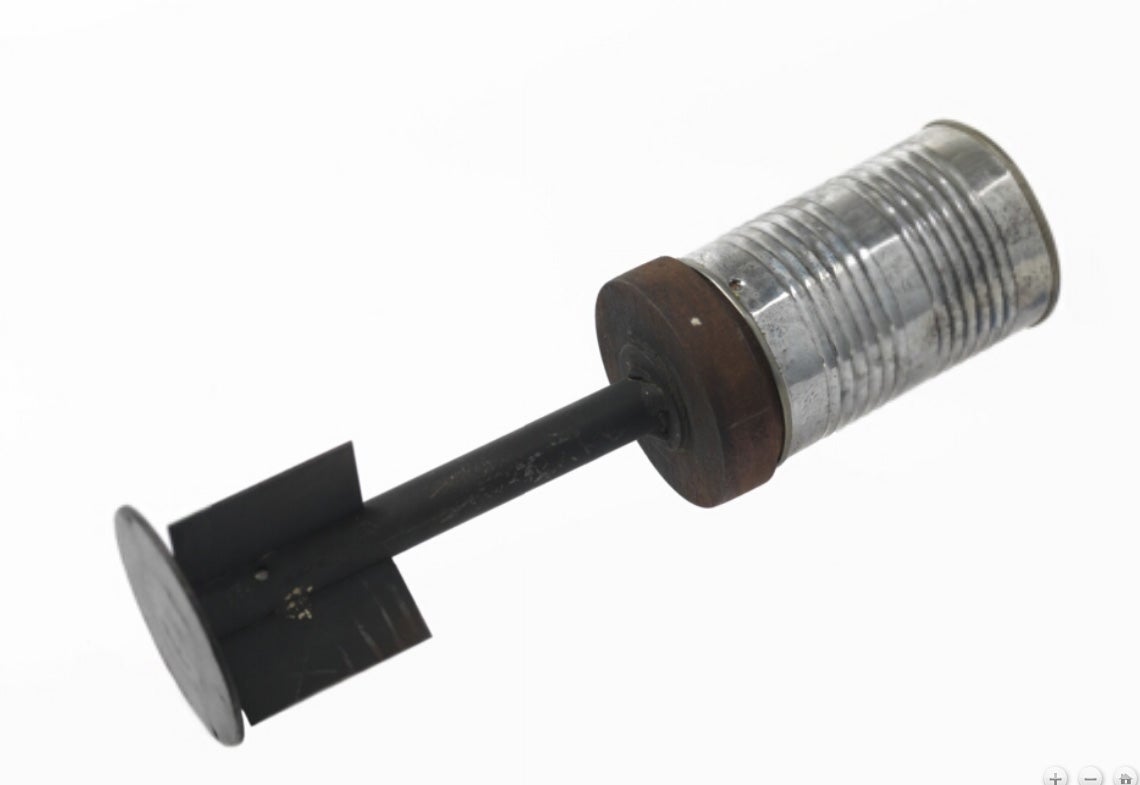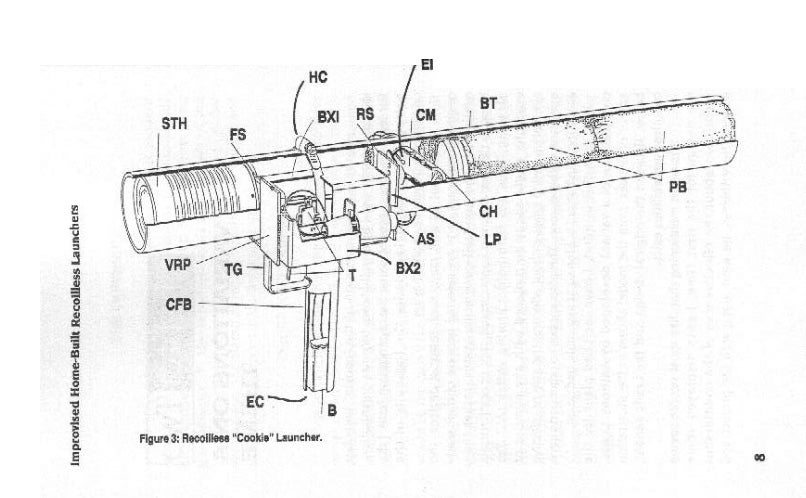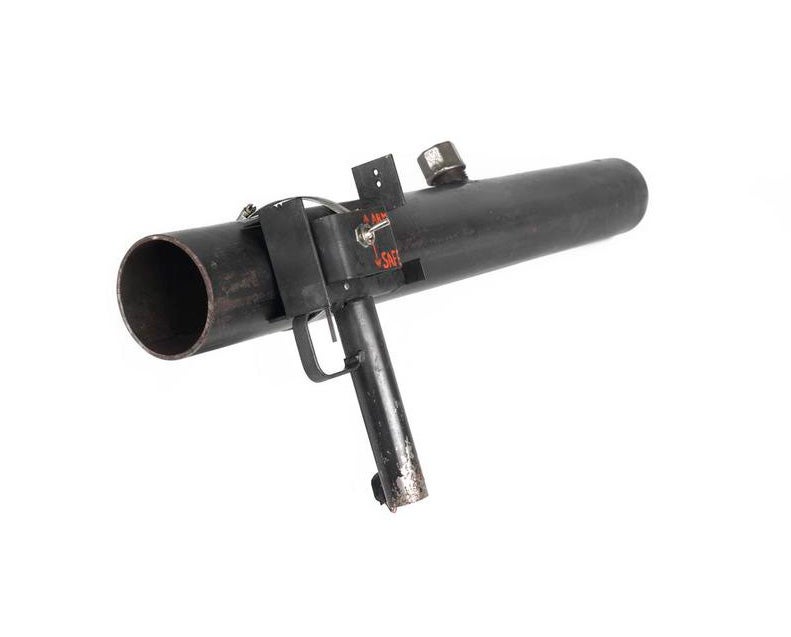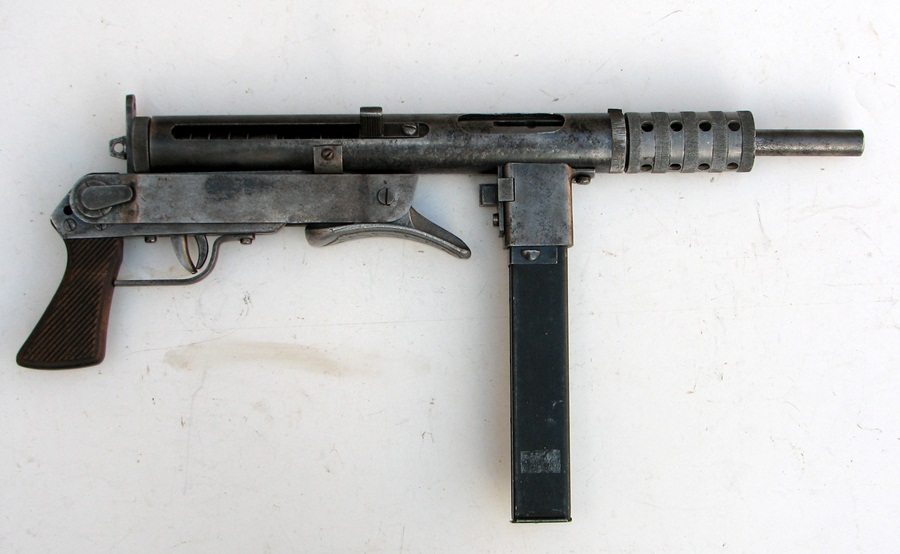During my recent researches of things Soviet I came across the following rather nice illustration. As is so often the case with these posts, another topic I had been reflecting upon had relevance here. This is not going to be a post on fighting with entrenching tools. There will be treatment of this topic in time, included a little known, possibly exclusive technique that most of you will not have encountered.
Those of you that have read my books will know that I advocate that you should have at least one weapon that can be accessed by your weaker hand. There are a number of scenarios wherein your stronger arm can get trapped, grabbed or wounded. In such a situation you should be able to use your other hand to bring a weapon into action. In the time of the Japanese samurai combats would often end in grappling, the winner being the one who could manoeuvre his opponent to a position from where he could insert a dagger trough a weak point in his opponent’s armour. Such grappling combats were actually fairly common in other cultures that used armour. I use Japan as an example since there are records that some samurai ensured that they wore a dagger on either side of the belt so that they could draw a weapon no matter which arm was entangled with an opponent.
As well as arming both sides, one should also be aware of the danger of having all you weapons on one level. I have been reading about some instances when police officers have been attacked with a tackling action. Since all of a cop’s authorized weapons are generally carried on his belt an attacker hugging him around the waist prevents him from drawing a weapon. The tackler does not need to be a skilled grappler to exploit this position. He can just hang on long enough for his friends to stomp the cop or steal his weapons and turn them against him.
Obviously, having weapons accessible at different levels is prudent. Many soldiers carry a knife on their webbing suspenders. I discuss this further in my second book as the “Pec Knife”. The positioning of such a knife allows it to be accessed with either hand even when one is down on the ground.
During the Second World War many soldiers and SOE agents carried small thumb knives or lapel knives. As the name suggests, these could be concealed behind a suit or uniform lapel. They were also hidden behind trouser braces, cap badges and a wide variety of other places. The lapel knife sheathes were provided with button holes so they could be attached to a button sewn wherever the user desired. At least one agent placed his knife in his inside pocket so he could draw it when asked for his papers.

Many readers will have heard of the “Sap Cap”, a baseball cap with a weight sewn in the back. Some of you will know that this commercial product is predated by “do it yourself” articles that suggest pinning a fishing weight in the back of a hat. The other day I came across a Russian source that advised soldiers to sew a piece of lead 30 x 20 x 1.5mm into the back of their uniform hats. This was a peaked “patrol hat” type item but I suspect that it would work with a beret too. Given that lead is toxic and can be absorbed through the skin I’d not use it in a hat unless it was well insulated. Steel shot, lead-free fishing weights and steel washers have been used instead. The piece of lead suggested above would have weighed less than a third of an ounce so a great weight or mass is probably not needed. As well as the obvious offensive use a sap-cap can be used to strike a hand holding a knife or thrown in the face to create a distraction.
The Soviet soldier using his helmet as a weapon obviously reminded me of the sap-cap idea. A helmet held in the hand also makes a pretty useful buckler against a knife or bayonet. As an aside, in his army days in Malaya my father sharpened the brim of his steel helmet.
If you are armed, you need weapons accessible by either hand. You also need plan for the situation that a weapon may not be accessible due to posture, body position or enemy action. And finally, you need to understand that if attacked there may not be time to draw a weapon. Often attempting to draw rather than initially countering an attack can be a fatal mistake. Your hands, boots and other body parts are the weapons you never have to waste time drawing. Learn how to use them well.
If you have enjoyed this article or it has been helpful to you please feel free to show your appreciation. Thank you.
The Books
Three hundredth post today! Buy the books or the posts will continue!
Today’s blog is effectively an adjunct to Friday’s post on the equipment of a Soviet soldier. You will recall that the wartime Soviet soldier was not issued a blanket or sleeping bag. Instead he was expected to sleep under his greatcoat with his rain cape providing shelter.
I have often come across references to men sleeping under coats or cloaks and been a little bit puzzled. Even a long coat must be shorter than the man that wears it so how do you sleep under it without your feet sticking out? This weekend I came across an account of how the Soviet soldier achieved this. In true communist fashion it involved some teamwork! Note that the Soviet greatcoat had a half belt at the back that gathered some of the coat’s width in. When used for sleeping this belt was undone on one side so that the coat covered a larger area.
Here is how the Soviet Infantrymen did it:-
Blankets, which were brown, although issued in garrison environments were not issued for field use. Soldiers were expected to make do with greatcoats. Here is an example: "On cold nights I shared a greatcoat with quite a few of my wartime comrades in the fighting lines. Many of them have since fallen.
There is no brotherhood that binds people closer than the one that's born in the lines, and a shared greatcoat is one of its symbols. You feel warm and secure with a friend close by. Actually, there are two greatcoats for two. A shared greatcoat is just a figure of speech. So what happens to the second? Duffel bags or lambskin mittens (with two fingers so it's easier to shoot) are used for pillows. The individual tents that double up as cloaks are used as mattresses and the greatcoats are the blankets. The shabbier one covers the feet and legs and the newer one the upper part of the bodies. Both men settle down on the same side. If there is the blessed chance of taking off your boots, the feet are tucked into the sleeves of the greatcoat - a pair of feet to a sleeve. The upper greatcoat is pulled over the shoulder, the shoulder of one fits into the right sleeve, the shoulder of the other into the left. The result is a kind of sleeping bag, warm and cosy. If it gets inordinately cold, the greatcoat is pulled over the heads - one head in one sleeve, the other in the other. When one side goes numb and the other freezes stiff, both men turn over simultaneously and the fitful sleep of the soldier continues."
I have updated Friday’s blog with a link to this account.
If you have enjoyed this article or it has been helpful to you please feel free to show your appreciation. Thank you.
The Books
As is now an established tradition, the Friday post will be a little more diverse than usual (Although yesterday we had a bomb thrower that used biscuits to work!).
I have been reading a little about the Battle of Berlin (the 1945 one). This lead me to look at Soviet infantry equipment.
In military circles “simple and effective” is often synonymous with “Russian”. The Soviet solder did not seem to carry very much, but what he did carry was surprisingly well thought out. Reducing the soldier’s load is a long running topic of debate so it is worth having a look at how the Soviets approached this. This is going to be just a quick thumbnail sketch of Soviet equipment so for brevity I will not go into great depth. There are many fine websites that can give you details such as introduction dates, model numbers, variations and so forth.
The first thing that becomes apparent is that some of the infantry equipment was very similar to that of the German soldier. Of course, during the war a lot of German equipment was used by the Soviets and the similarities often do not make this obvious in photos. Many readers will be familiar with German belt order items so for convenience I will refer to these for purposes of comparison.

The first thing you notice when comparing the German and the Soviet is what is not there. The German routinely carried his mess tin and breadbag on his belt. Sometimes the mess tin was attached to the yoke or a backpack but carry on the belt was very common. The Soviet seems to have preferred to carry his mess tin in his backpack or tied to the outside. The Soviet mess tin was a kidney section pail of similar design to the German. An older pattern of circular pail was also in use. There was a Soviet version of the breadbag but it does not seem to have been so widely used. Again the Soviet seems to have preferred to carry his rations and personal items in his pack. The breadbag may placed inside the pack rather than being worn on the belt.
Another “missing” item is the bayonet scabbard. The German usually placed his bayonet over his entrenching tool. The Soviet rifle used a socket bayonet that was kept permanently attached to the rifle. The standard bayonet had a screwdriver tip for adjustment of certain parts of the rifle. It was also a handy implement for clearing a jammed cartridge. Some other Soviet weapons had folding bayonets. No bayonet scabbard was issued in wartime since they were not needed. Bayonet scabbards tend to be all metal and on the heavy side in my experience, so this policy may have saved the Soviet soldier a few ounces of unnecessary weight. While the bayonet was a useful fire poker, screwdriver, pot lifter and candlestick it was not much use as a utility knife. Scouts and some other troops might carry the NR-40 knife. Other blades such as German trench knives or Finnish puukot might also have been carried.
An iconic equipment item of the German soldier is the metal canister used to carry his gas mask. The Soviet equivalent was a canvas bag carried near the left hip. Once it was accepted that gas warfare was unlikely Soviet soldiers often did not bother to wear this bag. Some removed the gas protection equipment and used the bags for more useful items.
So what did the Soviet soldier carry? There would be an ammunition pouch. At the start of the war a pouch was worn each side in the same fashion as a German soldier. Reenactor websites I have viewed are insistent that it became routine to wear just one ammunition pouch, which was positioned on the right of the belt. A grenade pouch was usually worn on the left side. The belt would also carry a water bottle.
 The final belt item was an entrenching tool. The German soldier seems to have favoured carrying this on his left side, sometimes towards the rear. In contrast the Soviet carried his on the right side. A dense items such as an entrenching tool might injure the wearer if it was fallen upon so the Soviet e-tool was on the flank, with the ammunition pouch preventing it creeping forward. Alternately the tool was tied to the pack. If the tool was expected to be urgently needed for close combat it might be tucked through the front of the belt. Several designs of carrier were used for the e-tool. The simplest and most interesting is the one shown below. The shaft is passed through a loop and a flap used to secure the top. The flap is fastened by a button, toggle or popper. It is both a quick draw and minimum weight solution!
The Soviet’s kit was not limited to what was on his belt. We have mentioned his backpack several times and have discussed the design of this item in another blog. The classic image of the Soviet soldier has him with a blanket roll across his chest. In actual fact this item is a rolled greatcoat. Russian soldiers were not issued blankets and were expected to use their greatcoat to sleep under. Note that the rolled greatcoat was always worn from the left shoulder to the right hip so that the rifle or SMG could be properly fired from the right shoulder. Alternately the greatcoat horseshoe was tied around the outside of the pack.
Another important item was the shelter cape or “Plash-palatka”. This was rather ingenious square of cloth that served as basha-sheet, tent component and rain cape. As can be seen, this is a 180cm square of canvas with button holes in each edge and grommets at the corners. One side has toggles next to the button holes (top edge in diagram). There is a single arm slit near this side. One corner (top left) has two drawcords in channels. Not shown in the diagram is that there is a toggle sewn some distance toward the centre from the bottom right corner. When worn as a rain cape the toggle is passed through the bottom right grommet to prevent this corner trailing on the ground.
The final belt item was an entrenching tool. The German soldier seems to have favoured carrying this on his left side, sometimes towards the rear. In contrast the Soviet carried his on the right side. A dense items such as an entrenching tool might injure the wearer if it was fallen upon so the Soviet e-tool was on the flank, with the ammunition pouch preventing it creeping forward. Alternately the tool was tied to the pack. If the tool was expected to be urgently needed for close combat it might be tucked through the front of the belt. Several designs of carrier were used for the e-tool. The simplest and most interesting is the one shown below. The shaft is passed through a loop and a flap used to secure the top. The flap is fastened by a button, toggle or popper. It is both a quick draw and minimum weight solution!
The Soviet’s kit was not limited to what was on his belt. We have mentioned his backpack several times and have discussed the design of this item in another blog. The classic image of the Soviet soldier has him with a blanket roll across his chest. In actual fact this item is a rolled greatcoat. Russian soldiers were not issued blankets and were expected to use their greatcoat to sleep under. Note that the rolled greatcoat was always worn from the left shoulder to the right hip so that the rifle or SMG could be properly fired from the right shoulder. Alternately the greatcoat horseshoe was tied around the outside of the pack.
Another important item was the shelter cape or “Plash-palatka”. This was rather ingenious square of cloth that served as basha-sheet, tent component and rain cape. As can be seen, this is a 180cm square of canvas with button holes in each edge and grommets at the corners. One side has toggles next to the button holes (top edge in diagram). There is a single arm slit near this side. One corner (top left) has two drawcords in channels. Not shown in the diagram is that there is a toggle sewn some distance toward the centre from the bottom right corner. When worn as a rain cape the toggle is passed through the bottom right grommet to prevent this corner trailing on the ground.

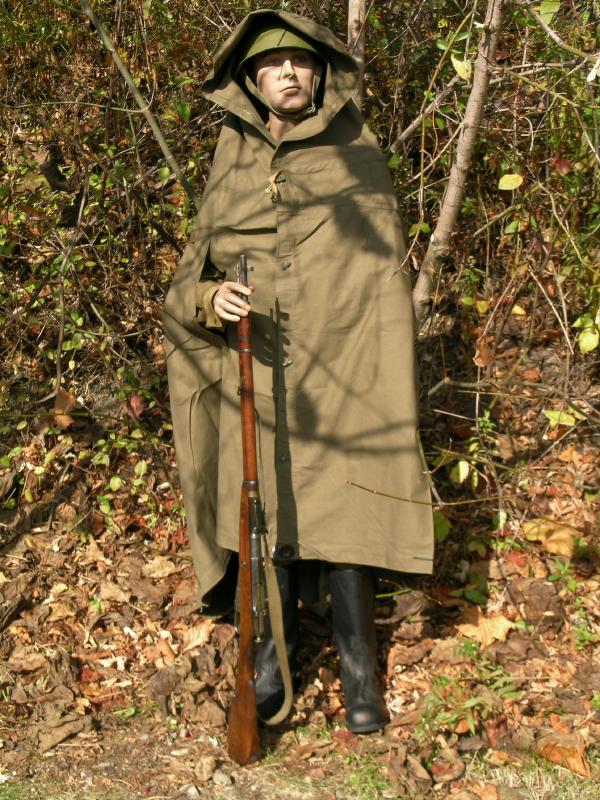
When used as a rain cape the drawcords are pulled in to form that corner into a hood. The opposite corner is folded up and secured as described in the previous paragraph. The right arm is passed through the arm slit to operate the weapon. The left arm comes through the front opening of the cape but maintains a good drape of cloth over the left side to keep off the rain and provide concealment. This really is a well thought out design!
The Plash-palatka on its own could be used as a shelter or combined with others to form a variety of structures. Some of these are illustrated in the Russian manual. The preferred method of joining them appears to be lacing them together through the button holes. This may be because only one side had toggles and this side would have to be placed lowest to prevent rain entering through the fly of the arm slit.
For turning the Plash-palatka into a shelter the soldier also carried two sections of tent pole, a wooden peg, a metal peg and four foot of guy rope. This could be compactly stowed in a small back and the resulting package was the right length to fit widthwise in the backpack! It could also be tied to the outside of the pack if interior space was limited.
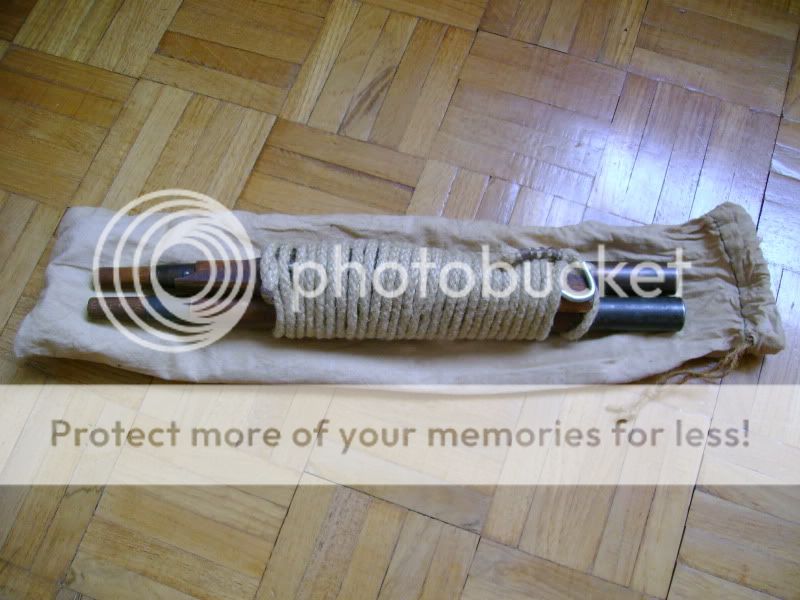
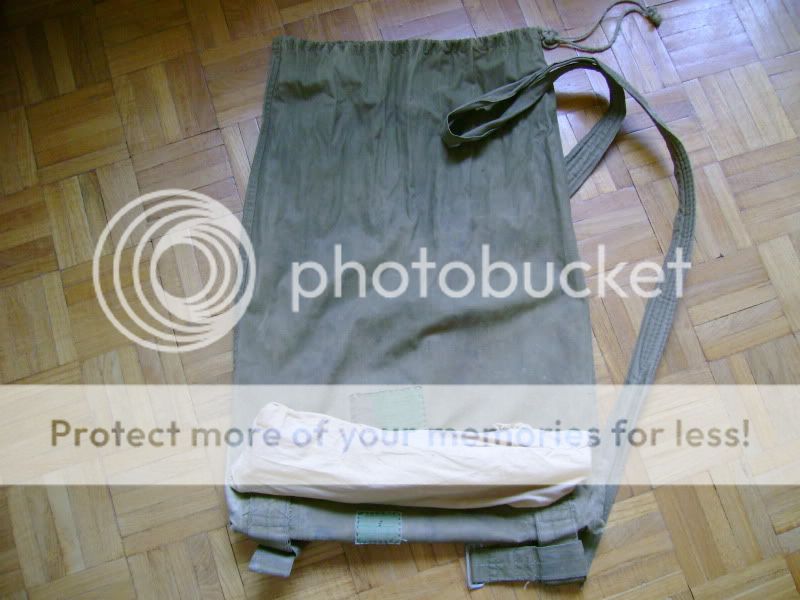
The Plash-palatka might be carried folded up inside the backpack. If the rolled greatcoat was carried it might be rolled around the greatcoat to keep it dry. When the greatcoat was not carried the Plash-palatka might be rolled up and carried from the left shoulder to the right hip in the same fashion that the greatcoat was. The folded item might also be carried attached directly to the yoke straps as is shown in an earlier photo.
My researches also brought me to the combat load of a cold-war era Soviet Motor Rifleman. Very little has changed! The design of ammunition pouch is different to suit the AKM and a bayonet in a scabbard is now worn. The gas mask case is back and a rolled NBC suit is attached to the yoke, just above a shelter cape.
If you have enjoyed this article or it has been helpful to you please feel free to show your appreciation. Thank you.
The Books
A recent blog post was an illustration of how easily firearms such as sub-machine guns can be manufactured. Where local laws have created a sufficient market criminal organizations may readily act to meet the demand. One of the weapons I showed had been designed and constructed in Northern Ireland in what was then one of the most heavily policed areas of the United Kingdom. Where there is a will and a need a way will always be found.
What I did not state in my earlier post was that the Irish SMG shown had been built by a Loyalist Irish faction. As far as I know the republican terrorists did not produce a significant number of homemade SMGs. The PIRA/IRA etc were well supplied with small arms from both Libyan and American sources. Where the IRA were very creative was in the field of heavier weapons. Yesterday I came across this interesting home-made weapon. It is a recoilless bomb thrower designed to attack unarmoured and lightly armoured vehicles. The projectile is made from a tin can containing a shaped mass of explosive. The weapon works on the Davis principle and uses two packets of biscuits as counter-shot. The local pigeons must look forward to a firing!
The firearmblog webpage on this device does a fine job at describing the device, so I will direct you there.
If you have enjoyed this article or it has been helpful to you please feel free to show your appreciation. Thank you.
The Books
 One of the books I own has this interesting illustration and entry. I would be inclined to describe this as a “tabard” but the book calls it a body-apron, or more properly “Die Heeres Tarnungs Köper-Schürze”. One side was white while the other side had a camouflage pattern. It was secured by two sets of camouflaged tapes which could be tied at chest level and waist level. It was probably intended to be worn over the webbing equipment, access to the ammunition pouches being via the side openings. The camouflaged smock issued at around the same time was also intended to be worn over the webbing and was provided with two pocket-like openings. In practice it was more common to wear the webbing outside the smock and the same may have been done with the body-apron.
One of the books I own has this interesting illustration and entry. I would be inclined to describe this as a “tabard” but the book calls it a body-apron, or more properly “Die Heeres Tarnungs Köper-Schürze”. One side was white while the other side had a camouflage pattern. It was secured by two sets of camouflaged tapes which could be tied at chest level and waist level. It was probably intended to be worn over the webbing equipment, access to the ammunition pouches being via the side openings. The camouflaged smock issued at around the same time was also intended to be worn over the webbing and was provided with two pocket-like openings. In practice it was more common to wear the webbing outside the smock and the same may have been done with the body-apron.
Today I found a couple of additional illustrations of this item in differing camouflage patterns.
The version below was a post-war design used by the German border guard (Bundesgrenzschutz or “BGS”). This version was made of waterproofed material and intended to also serve as rainwear. It fastens with poppers rather than tape.
While I was trying to locate an on-line picture of the German body apron I came across the following interesting photographs.
These soldiers are from the New Zealand 24th Auckland Battalion. These photos were apparently taken in Italy in 1944. These are obviously not the German body-apron, which had a V-neck. The Kiwis most likely made these themselves from captured German or Italian camouflage material. Notice that the webbing and pouches have been marked with paint/dye/blanco to add additional camouflage effect and that at least one soldier also wears camouflaged trousers. I have seen it suggested these troops have been through “sniper school” but the variety of armament displayed makes me sceptical of this. We see Bren guns, Thompsons and a 2” Mortar but no scoped rifles are evident. The Imperial War Museum collect includes photos of other Commonwealth troops using tabards including one of the 1st Guards Brigade.
Camouflaged clothing can be very expensive. These photographs illustrate that reasonably effective camouflage gear can be produced no matter how basic your tailoring skills. In another illustration I have is of German troops in Normandy wearing sleeveless “string vests” designed to hold foliage. There is no reason why a camouflaged tabard cannot be improved further with some bits of frayed cloth, scrim and netting.
Watch news footage from the middle east and you will note that American soldiers are very easy to identify. Their black or woodland camouflaged body armour appears as a dark blob. This must make a very nice aiming point. Fifteen years of conflict and still this has not been addressed. For several decades I have been advocating that modern soldiers should use camouflaged smocks large enough to fit over their body armour. (And place the knee pads under the trousers while you are at it!). Constructing tabards from any suitable shade of available cloth would quickly fix this problem.
If you have enjoyed this article or it has been helpful to you please feel free to show your appreciation. Thank you.
The Books
In several of my blogs and in my second book I have suggested that restrictions on gun ownership could create greater opportunities for the supply of legal weapons by organized crime. Tons of narcotics are smuggled across our borders every month and the same routes can be used to import illegal weapons. This is only one option, since firearms can easily be produced in any reasonably furbished workshop.
To illustrate :
This is the Polish Blyskawica, an SMG designed and produced by the Polish resistance while occupied by the Nazis. The Sten and MP40 inspiration is plain here, but this is an original design. It includes a floating firing pin, something of a refinement over many of the SMGs then in common use. The Poles also produced their own copies of the Sten gun, as did many other peoples under Nazi domination. The Danes even built a "baby sten" (below).
Another Sten inspired weapon, the German MP3008 (above). This was designed to be cheaper and easier to produce than the MP40. 10,000 were made, the Volksstrum receiving many of them.
The EMP 44 (above) was an even simpler German weapon designed to be fabricated from piping. The chunk of metal that mounts the rear sight also reinforces a potential weak spot where the barrel joins the receiver. Only produced as a single prototype.
The Cook SMG (above) from the 50s is another prototype. Essentially it is a sten gun that placed the trigger before the magazine well.
The International Ordinance MP2 was another simple weapon that used Ingram M10 magazines. The foregrip has storage for a reload. The Cellini Dunn SM-9 was a very similar looking weapon.
The MP2 has inspired other simple designs too…
The following guns were manufactured in Ireland during the troubles. Despite the presence of the British army and other security forces weapons still got made or smuggled into the country.
When it comes to easily produced designs the Sten gun is usually mentioned. It is worth remembering that the Sten and many of the designs shown above were intended as a battlefield weapons. More compact and more easily concealed weapons can easily be created. The prototypes below are Mk IV Sten guns intended for airborne troops. Similar weapons would be attractive to criminals and could very easily be produced.
Illegally-produced weapons similar to the Encom MP (below) or the Danish Baby Sten could easily become commonplace if we create a market for them.
If you have enjoyed this article or it has been helpful to you please feel free to show your appreciation. Thank you.
The Books




















